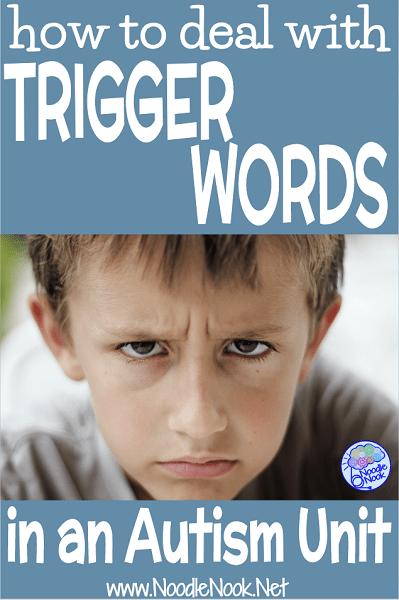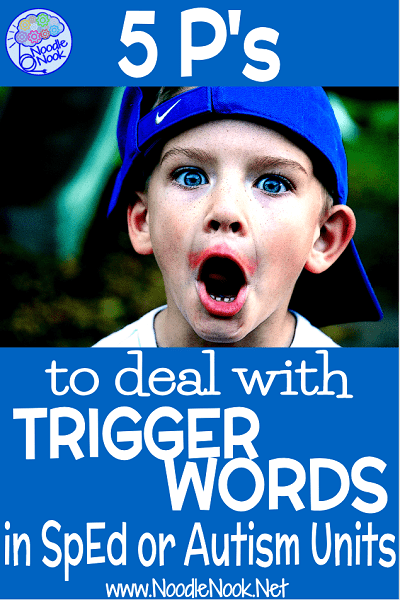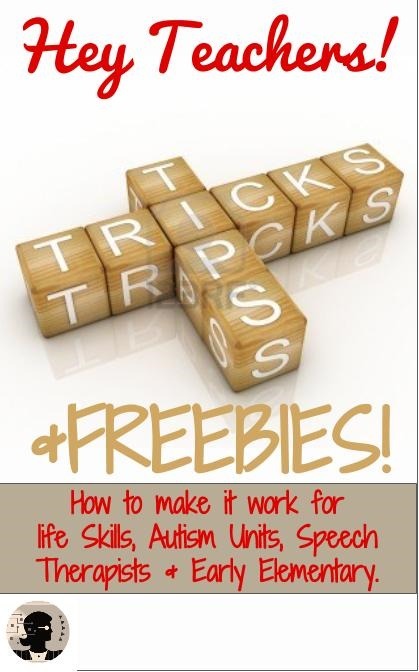Dealing With Trigger Words
Not that long ago, I did a personal consultation with a mom who was at the end of her chain. She had sent me a list of trigger words that no one in her home was allowed to say before I even stepped foot in the house. I was warned that saying a trigger word would cause her son to start having behaviors.
For her son, behaviors included throwing objects, screaming uncontrollably and loudly, or self injurious behavior (hitting leg or head with a closed fist). Being me, the first thing I wanted to do was walk in the door and start saying some words off of the list.
What words? No. Stop. Bathroom. And his name to start. There were 18 words on the list… and all of them were words you absolutely needed to communicate with him or that he would hear in other settings.
And, before you even ask, he would have the same reaction if he heard those words as others talked in passing (like at church, at a restaurant, or the doctor’s office). For this mom and her son, these trigger words were absolutely impacting both of their quality of life.
So, here I come walking in the door, trying to make a plan to help. Below you will find some suggestions on where to start if you find yourself in the same situation and I will let you know how this family faired down below.
Steps to Dealing with Trigger Words
Where to start with a trigger word, in the classroom or at home, is to start by paring down the verbal language. This boy heard no so many times, it finally started pushing him over the edge. And when he had a behavior, people around him stopped repeating it.
My guess is that someone somewhere overstimulated them with too much language. When you start with your verbal instruction or directives, use as few words as possible.
“Stop that and finish your work” should be pared down to “Do your work” or simply “work”.
Decrease the language.
Pair Words with Visuals
With the move to lower the language, start to use a visual to pair with the language. Depending on the severity of the behavior, you may have to completely eliminate the verbal directive in the beginning and just present the visual directive. Then, as time progresses, present the visual and then add the words (including the trigger word) back in.
Rehearse the Procedure that Comes with the “Cue”
You are using the trigger words to get an outcome. That means you will want to train the behavior that follows the trigger word.
For example. I say ‘Bathroom’ and I want a specific outcome. What I don’t want is uncontrollable screaming that leads to pant wetting.
Going through the process of making a step by step visual checklist of the bathroom procedure so that when I say bathroom (or a replacement word in the interim) is so helpful. The visual guides the steps and allows them to practice or rehearse without getting caught up in the triggered behavior..
Find the Reward or Praise that Works
We talk all about the function of behavior here and here, so be sure you read those posts when you’re done. When you are working on changing behavior, you are going to need a good reward. You are going to have to find what a student likes and is willing to work for. And, very likely, when you are dealing with trigger words, you are going to have very few things to choose from.
When you do find something that will work, only use it when you are dealing with trigger words and make it that tolerating the trigger word is the only way to get that preferred reward.

Practice the Planned Ignore
The reason trigger words work for a kid is because they stop those around them from continuing nonpreferred behavior. If I scream, you go away. If I throw things, you will stop talking to me. The behavior is effective because it worked so it continues, hoping it will keep working.
If you want to change the behavior, you have to change the outcome.
Planned ignoring can help. You make a demand, the behavior happens, instead of stopping the demand, you ignore the behavior and remake the demand.
This strategy is not for the weak of heart. Things will get worse before they get better. If you are willing to have a battle of wills, it can be effective.
Dealing with Trigger Words
So, to recap, when you are dealingwith trigger words, follow the P’s:
- Pare: Pare down the verbal and use neutral words.
- Pair: Pair words with visuals and start by presenting the visual first.
- Procedure: Rehearse the procedures that comes before the verbal cue.
- Praise: Use a reward system and pour out the praise.
- Planned Ignore: Prepare yourself to ignore the behavior.

How It Worked For Me
So, and for this wrap up, I will refer to the boy as Will… he was a tough nut to crack. I saw him several days a week across a semester. I started with PARE.
Oi.
Any and I mean ANY mention of the trigger words caused a episode. A bad one. Every time.
I skipped to PAIR and introduced a visual (without pairing it with a verbal cue), I triggered the behavior just as bad.
And I went home, ego bruised, and had to rethink.
Then I remembered the last ‘P’… persistence.
I went back, Pared and Paired… failure. Again. Failure. Again. Less failure.
After about 3 months… I said a trigger word and didn’t get an ear full. Then about 3 weeks later, it happened again. At that point, I prepped some visuals for the bathroom steps and started in with saying that trigger word. Pain, flying paper, and temper tantrums ensued.
The long and short of it is of the 18 trigger words, we can now say 3 consistently without issue and another 4 sometimes. And I take that as a total win.
These tips will work, but don’t forget the consistency piece.
Article Citation: [cite]




Do you know alot about autism and trigger words? Is there a way that if you do I could talk to you and reach out to you? My school is doing a project and we would like speakers.
Hey Kathryn!
I do professional speaking and teacher trainings throughout the year. Email me at ajones@noodlenook.net and I can get more information to better support you and your school.
Thanks!
-Ayo at Noodle Nook
Comments are closed.